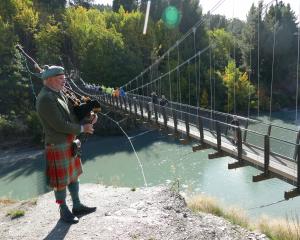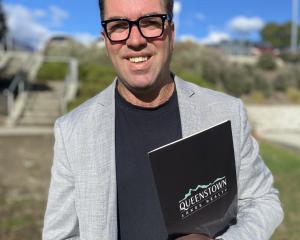What rats do not know kills them.
Clever little vermin though they are, the bird nest busters have not worked out the green oatmeal pellets which rain down on their homes is not mana from heaven and they should not eat it.
The foraging predators hoard the bait in their underground nests but their attractive new larder is fatally laced with low doses of anti-coagulant pesticide, acting a bit like a blood thinner.
It can take several days for the poison to do its work but scientists say the rats are unable to make the connection and keep eating the bait.
Retired agricultural helicopter pilot Peter Garden (65) is one of New Zealand's keenest rat exterminators.
Since the death of his wife Margaret from brain cancer several years ago, Mr Garden has been travelling the world, dropping poison-laced pellets from his helicopter on rat-infested islands.
Opportunist rats have accompanied ship-loads of humans all over the world, making landfall from Codfish Island, in New Zealand to Desecheo Island, off Puerto Rico, and Rat Island, in Alaska.
Omnivorous and fecund, rats have caused substantial food supply shortages in human populations, for example in the Aleutian Island chain or in the Inner Hebrides, but nesting birds and their eggs are their primary victims.
Mr Garden now lives in Wanaka, but his helicopter company was previously based in Riversdale, Invercargill and Gore.
He obtained his fixed-wing pilot's licence in 1965 and his commercial helicopter qualifications in 1976.
He spent a lot of his younger days working as a ground hunter, but was not in the venison industry in a major way, he said.
New Zealand is a world leader in rat eradication, through the work of the Department of Conservation, the Forest and Bird Society and the late conservationist Dr Don Merton, who died last year, aged 72.
Mr Garden's relationship with Doc and Dr Merton were important ones and helped create the work opportunities he enjoys today.
He worked as a pilot on Dr Merton's kakapo recovery programmes and still works with Peter McClelland, Doc Southland's programme manager offshore islands.
Over the years, he has gleaned an in-depth knowledge of rats and rat behaviour.
"I started this type of work in the mid-90s. To give it a broad term, it is called habitat enhancement or habitat restoration.
"A lot of habitats around the world have been seriously damaged by human intervention, and a lot of it by invasive species. The most invasive species of all is the rat.
"Rats have been responsible for untold thousands of exterminations, including humans," Mr Garden said.
One example of a rat-inflicted human "extermination" occurred centuries ago on the unfortunately-named Rat Island, where Mr Garden recently worked.
Brown rats (Rattus norvegicus or Norway rat) arrived on the 15km-long, 5km-wide island in the late 1700s, as a result of a Japanese sailing ship wreck.
The Aleuts relied on their walrus-skinned kayaks for hunting and travelling, but the rats ate the kayak skins and, deprived of their means to hunt, the people starved to death, Mr Garden said.
For obvious reasons, Rat Island earned its name in 1827 from a passing sea captain, but recent habitat restoration projects by the United States Fish and Wildlife Service and two private trusts, The Nature Conservancy and Island Conservation, have enabled the island to be declared rat free and revert to the Aleut name, Hawadax.
New Zealand's first island rat eradication occurred because Dr Merton wanted to relocate the world's rarest parrot, the kakapo (there are about 126), from Fiordland to a safe breeding area on Codfish Island, near Stewart Island.
That could not happen before Doc had eradicated Pacific rats (known to the Maori as kiore).
Mr Garden helped with aerial bait trials on two small islands in Foveaux Strait, using new aviation GPS technology and coagulant bait products.
"We successfully eradicated rats from those two islands without knowing too much about it.
"We refined our techniques and then started on Codfish [in 1998] and, as a result, eradicated rats from Codfish.
"The guys in Doc's Southland conservancy then thought they would try eradicating rats on Campbell Island," Mr Garden recalled.
Conservationists working on a project to save the very rare magpie robin in the Seychelles Islands consulted Dr Merton about their project, leading to an invitation to Mr Garden to work on a rat eradication project there.
"Don said, 'You are not going to get anywhere with them until you kill the rats'. So we successfully eradicated rats in the Seychelles.
"That was before we did Campbell Island. From there, it built up momentum," Mr Garden said.
He has also helped kill rats in Fiordland and Lake Manapouri, in South Georgia, Alaska and on several Pacific Ocean islands.
Each mission is a major logistical exercise in getting equipment, fuel and people to remote islands far from mainland services.
Mr Garden took a five-day, 1400km journey by sea from the Falkland Islands to South Georgia last year to join "Team Rat", led by British zoologist and Dundee University Professor Tony Martin, for the South Georgia Heritage Trust.
Mr Garden was employed as flight operations manager and because of the island's remoteness, the trust purchased its own helicopters and stores them in the Falklands.
Mr Garden flew a twin-engined Bolkow B0105 five-seater chopper built for Jackie Onassis and more recently used as an air ambulance in Hampshire, UK.
Having twin-engine capability was a distinct advantage when working in inhospitable terrain and despite its 30-year vintage, the Bolkow was "like an axe that's had five new heads and two new handles. It had been kept in good order".
South Georgia became part of British territory after Captain James Cook claimed it in 1775.
The explorer Ernest Shackleton (1874-1922) is buried there.
For a long time, hardly any fur seal, whale or king penguin was safe from humans and their melting pots but eventually the unforgiving stormy environment forced people to go home, leaving behind countless rats and a few hundred introduced reindeer.
Now just a few people - mainly scientists - visit each year.
But it seems the bird population has also shrunk.
"I would not be surprised if more than 90% were missing," Prof Martin told Geo editor Ines Possemeyer, of Germany, who observed Team Rat in action last year and wrote about it in the March 2012 magazine edition.
(Team Rat was also the subject of a television documentary).
Mr Garden said South Georgia could be treated piece by piece, because large glaciers subdivide the land and rats cannot cross them.
Poisoned bait was dropped in February and March 2011 and it was interesting to him that soon after, scientists were reporting South Georgian pipits around the old Grytviken whaling station, where they had not been seen before.
In May last year, Mr Garden dropped bait on three unoccupied island groups in the Pacific Ocean: Palmyra Atoll (about half-way between Hawaii and American Samoa), the Phoenix Island group (near Kiribati) and Henderson Island (near Pitcairn Island).
On all three missions, Mr Garden was employed as chief pilot for a multi-agency operation funded by various authorities and trusts and directed by the Island Conservation trust's Alex Wegman, of the United States.
Because of access issues and remoteness, two Bell Jet Ranger helicopters worked from the deck of the RV Aquila, an Alaskan crab boat captained by Kale Garcia, of Seattle.
A heli-deck was built on three shipping containers and bait bags were filled on lower levels.
Helicopter fuel was also stored on board.
The Bell Jet Ranger was chosen because of its reliability.
"Because we are in remote areas, we don't have the opportunity to get in parts and engineers. So we need something that doesn't need much maintenance.
"Also having two or three choppers cuts out the risk of having aircraft down for maintenance and the operation is not held up," Mr Garden said.
Palmyra Atoll is under US sovereignty and its collection of islands sports an abandoned World War 2 airstrip, roads and causeways and other structures.
Black rats (Rattus rattus) have been eating Palmyra's sea birds and their eggs for about 200 years, so were bombed with 50 tonnes of poisoned pellets at a rate of 80kg per ha.
This is about double the application rate for other places.
Because indigenous land crabs eat the bait too, although their cold-blooded metabolism means they are not affected by the poison.
Unintentionally poisoning other species is a big concern for rat eradicators, and unfortunately, some birds do die.
It is a damned if you do, damned if you don't scenario, with scientists prepared to take some collateral damage for long-term gains.
Even so, steps are taken to protect birds. On Palmyra Atoll, scientists captured bristle-thighed curlews (about 7000 left), one of the world's rarest curlews and godwits, and released them when it was safe.
In the Seychelles, all 36 very rare magpie robins were also put into custody, with happy consequences.
"They bred in captivity, so they released more than 40 birds by the time we had finished," Mr Garden said.
The magpie robins now number about 170 and have come off the critically endangered list.
In March, Mr Garden was in the Caribbean to bait Desecheo Island, 22km off-shore from Puerto Rico, and survey another island near Antigua, for future rat eradication.
The rat team flew to Desecheo every day from their mainland base at a disused nuclear power station, because the island's rocky shore prevented a ship-based operation.
Soon, Mr Garden will be on Wake Island, halfway between Hawaii and Japan. Later this year, he has more work to do in Alaska and South Georgia.
All up, Mr Garden is away killing rats for about seven months each year.
While it usually takes two years to get detailed results from a bait drop, Mr Garden is thrilled by early signs of success on all the islands he has helped treat, and hopes the lessons can be applied to other habitats.
"The one thing that has invariably happened in all these jobs is the environment has bounced back very, very quickly.
On Desecheo, when the birds came back, they were reporting birds that had never been seen on the island before.
They knew they were on other islands ... obviously they had come back for nesting. That was just 10 days after we had finished killing the rats," Mr Garden said.
Mr Garden is now scouting for helicopter pilots with experience flying in remote, difficult terrain, with GPS navigation.
Graeme and David Gale, of Dunedin, Nick Torr, of Te Anau, and Derek Brown, of Nelson, and Gary Paterson, of Kingston, are among those who have already done a rat tour of duty.
South Georgia, particularly, requires pilots who meet strict European certification standards. The next important thing is the right mind-set, he said.
"You've got to be able to live in remote environments. It is not always comfortable.
"Things can get you down quickly.
"It is important to keep your morale high in these kinds of jobs," he said. Without a doubt the flying is adventurous.












